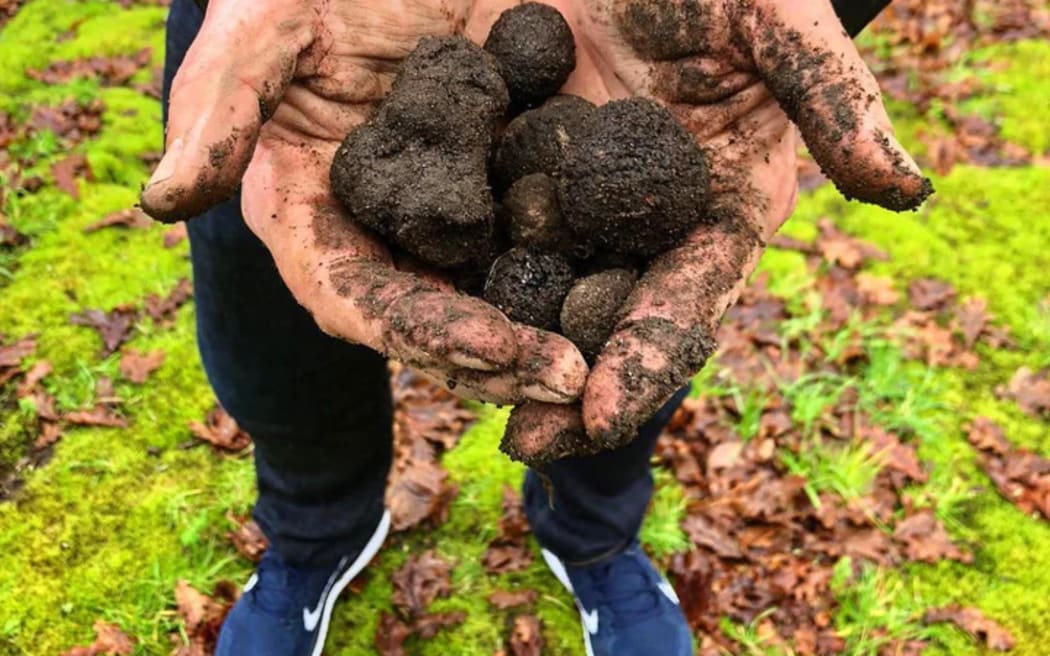Ohiwa Black Diamond Truffles has been given more than $155,000 by the government to encourage other landowners to grow 'black diamonds'.
The Bay of Plenty company is sharing their secrets of the industry to get the truffles growing on unproductive land.

Photo: Black Diamond truffles
Ohiwa Black Diamond co-owner Annette Munday tells Jesse Mulligan their journey with the rare fungi all started when they were purchasing a property in the area.
“The truffle industry, at that time, it was extremely secretive.
“So when we purchased the property it wasn’t more or less until we signed on the dotted lines that they then said oh, by the way, there’s the truffière. And we honestly didn’t have any idea what a truffière was let alone what truffle were.”
They’re often called the elusive truffle and used to take up to 18 years to grow, she says.
“They’re not something that pops up in front of your eyes, so they grow on oak and hazelnut trees in extremely poor soil, they like a really high pH [soil acidity or alkalinity].
“So, it’s more or less planting the seed, or the seedling, and then waiting for them to grow. Then using a dog or in some cases a pig to sniff out the truffle aroma so you can find the truffle.”
“Nowadays, we’re getting trees that produce around four to six years old, so we say to be realistic and expect truffle to be producing around six to 10 years.”
The best truffle can sell for $3 per gram, she says. Last year alone, Munday’s business sold just over 100kg.
“Each tree can produce anywhere from 200 grams to 1.5 kilo. So obviously the more trees you have, the more you produce.”
Her whānau are so used to truffle that they use it quite often in their meals, she says, but beginners only have to use a tad to get that aroma and taste.
“During truffle season, we walk in the house and all we can smell is truffles so we’ve had to get a second fridge because having truffle – even though they’re in sealed containers – [the aroma] still goes through our cheese, our milk, our butter.”
But the goal with their latest funding from the government is for the country to grow enough truffles for a robust export industry, she says.
“New Zealand is extremely low in volumes when it comes to producing truffle so we can’t meet the export demand.
“So, by having more people produce truffle, we’ll be able to then export truffle all around the world.
“We’re getting people from Singapore, Dubai ringing, just about weekly, wanting New Zealand truffle but they’re wanting 50 kilo a week, and that’s just one person.”
Some French chefs have told them New Zealand’s truffle rivals that of their native and prized Périgord, she says.
“In different countries, we all have different bacteria in our truffières which help the truffle produce the aroma and climate too has a lot to do with the heat of the soil which then gives different aromas from different places that you come to.
“So, our truffle here in the North Island might have a slightly different aroma to those truffle in the South Island.”
They’re now speaking to various hapū across the eastern Bay of Plenty with under-utilised land about growing truffles, she says.
“People that have land that can’t be utilised for growing other crops or for their cattle to graze on … it gives them a second income perhaps if they start planting truffle seedlings.”
Anyone keen to know more about growing them should get in touch, Munday says.
“Truffles are a great thing to grow … and also you look at the added value products that can also be used for the truffle.
“In New Zealand, we’re currently only using the raw product which is the raw truffle itself, and it’s only just now that we’re starting to dive into using truffle for the different properties it has in different products.
“We do a truffle oil, truffle salt and truffle honey, but there’s so many more products that can be made with the truffle.”

